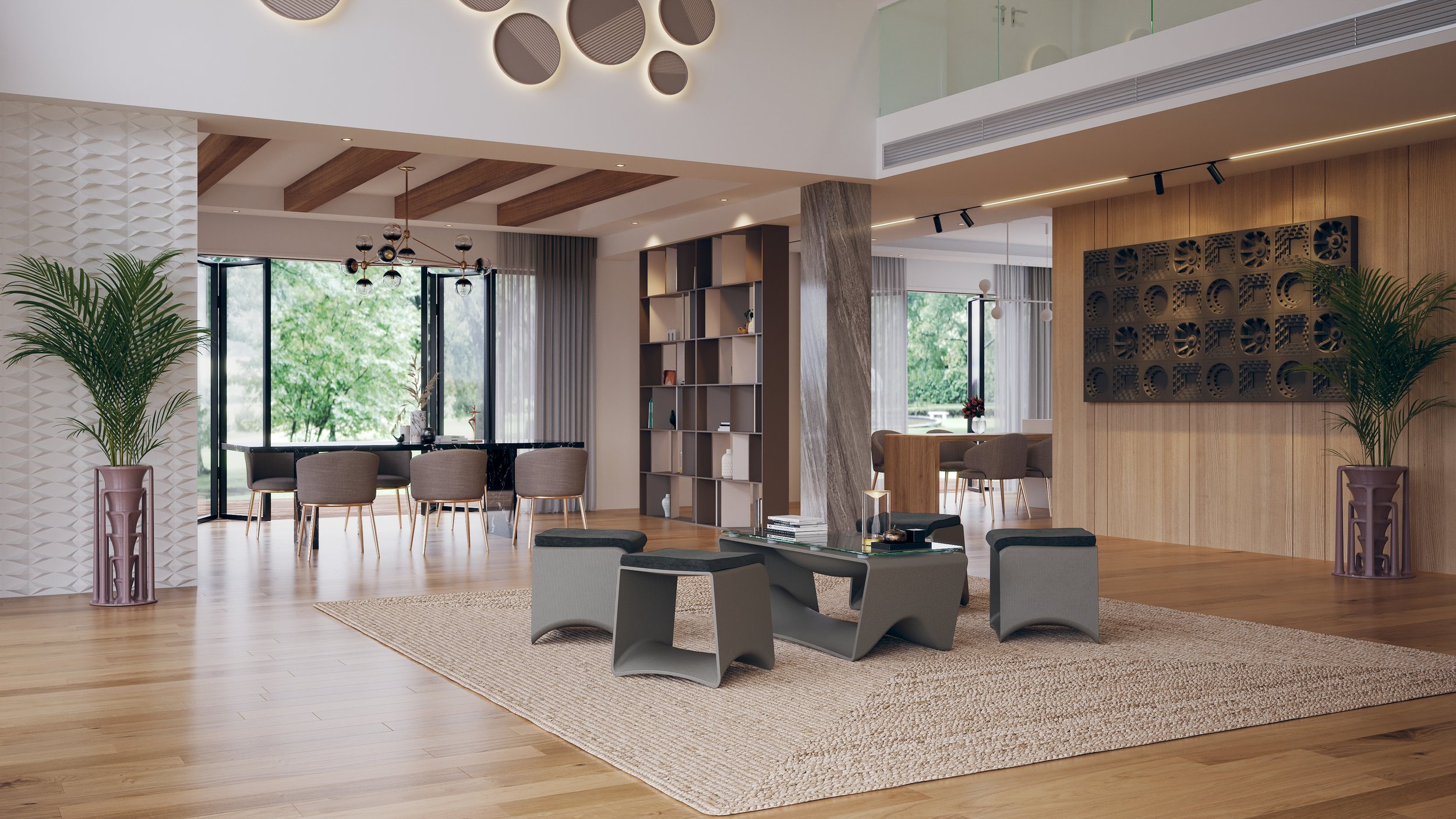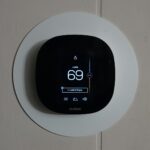What if the next industrial revolution wasn’t happening in a distant mega-facility overseas—but right in your own backyard, powered by artificial intelligence, recycling, and robot arms the size of cars? That’s exactly what’s unfolding in St. Petersburg, Florida, where Haddy, a trailblazing 3D-printed furniture startup, has officially opened a new microfactory that redefines what “local production” looks like.
And despite the name, this “micro” facility is anything but small: at 32,000 square feet, it’s now considered the largest operational 3D printing site in the world—not by square footage, but by output and the number of machines operating under one roof.
Image: Haddy
Haddy’s AI-Powered Microfactory in Florida Could Be the Future of Manufacturing
A Factory That Thinks for Itself
Inside the factory, eight towering robots—each with names like Ada, Clio, and Bumblebee—work in harmony to transform recycled materials into finished products. These machines don’t just follow orders; they learn, adapt, and optimize using cutting-edge AI and machine learning. The entire process, from design generation to material handling, is coordinated by Haddy’s proprietary software platform, creating a manufacturing line that’s as intelligent as it is efficient.
The output? High-quality furniture, modular home components, and more—all produced 16 times faster than any comparable system currently on the market. The robots are built for flexibility too, meaning Haddy can adapt product lines quickly based on demand, weather, or even community needs.
Sustainable and Seriously Scalable
Haddy’s mission isn’t just about speed and tech—sustainability is core to its DNA. The company uses reclaimed materials like post-consumer plastics and discarded fishing nets to manufacture its products, significantly reducing waste and environmental impact. What’s more, the local nature of the microfactory means shorter supply chains and lower transportation emissions, a stark contrast to the global manufacturing networks most companies rely on.
This approach paid off in real-world terms following Hurricane Ian in 2022, when Haddy quickly replaced destroyed furniture for a local coffee shop—illustrating how its tech can step in for disaster recovery and emergency infrastructure needs.
A Bigger Vision: Reindustrializing America
At the helm of Haddy is Jay Rogers, a Marine Corps veteran and the former founder of Local Motors (best known for 3D printing cars). Rogers is a vocal advocate for what he calls “reindustrialization”—the idea that manufacturing should come home, driven by software, robotics, and clean practices. With Haddy, he’s delivering on that vision in a way that traditional factories simply can’t match.
And this isn’t just a one-off. Haddy plans to roll out more AI-powered microfactories across the globe, targeting sectors like housing, defense, and construction. Each site will be a node in a decentralized network—local, fast, and ready to deliver on-demand.
The Bottom Line
Haddy’s St. Petersburg launch isn’t just about making furniture—it’s about reimagining how things get made. Combining AI, robotics, sustainable materials, and local logistics, this microfactory represents a powerful new blueprint for 21st-century manufacturing. It’s smart, nimble, and rooted in the communities it serves.
If the future of production is going to be cleaner, faster, and more resilient, Haddy might just be the prototype everyone else will try to copy.
Key Takeaways
- Haddy’s new 32,000-square-foot spot in St. Pete is now the world’s biggest AI-powered 3D printing operation—yep, sixteen times the capacity of anyone else.
- The factory blends advanced robotics with AI to turn recycled materials into sustainable products, right near the people who’ll use them.
- This approach could totally upend how things get made, making production faster, greener, and way more agile than the old-school methods.
Unveiling Haddy’s AI-Powered 3D Printing Factory
Haddy just threw open the doors to the world’s largest 3D printing facility in St. Petersburg. It’s a pretty bold move, merging advanced robotics and artificial intelligence to turn the usual manufacturing playbook on its head.
Factory Design and Layout
We’re talking 32,000 square feet of industrial space, tucked north of the EDGE District. Step inside and you’re greeted by these massive, crane-like robots—honestly, it feels more like you’ve wandered into a sci-fi flick than a standard factory.
The layout is clever, too. It’s built for efficiency, but also to show off the process. Each robot has its own turf, with materials flowing naturally from printing to finishing to quality checks. It’s tidy, but not in a sterile, soulless way.
Haddy’s leaning into the “microfactory” concept—smaller, nimbler setups close to where people actually live. That means less shipping, less waiting, and a production model that can respond in real time.
Key Technologies Integrated
At the heart of it all: eight custom robots, each one running on AI and machine learning. They’re constantly tweaking the 3D printing process on the fly for better quality and less waste.
AI manages a lot here:
- Picking the right materials
- Dialing in print speed and accuracy
- Keeping an eye on quality, non-stop
- Scheduling production so nothing gets bottlenecked
Most of the stuff being printed is made from recycled materials, which is a huge part of Haddy’s sustainability push. The company claims the place can pump out sixteen times more than any other 3D printing operation out there.
By fusing robotics with smart, AI-driven systems, Haddy can churn out furniture and other products way faster—and, arguably, smarter—than traditional factories ever could.
How Artificial Intelligence Transforms 3D Printing Operations
Artificial intelligence is the real engine under the hood at Haddy’s St. Pete factory. These AI systems juggle a ton of tasks at once, making large-scale 3D printing not just possible, but actually practical—and, dare I say, a little bit magical.
Automated Workflow Optimization
AI at Haddy’s place doesn’t just sit back and watch. It runs the whole show, from the first design sketch to the finished product. Incoming files get analyzed, and the system instantly figures out the best printing parameters, how much material to use, and what order to print everything in.
Those eight robots? They’re not working in isolation—the AI keeps them moving in sync, squeezing out every drop of productivity. That’s how they’re hitting sixteen times the output of their nearest competition.
And unlike old-school factories where every new product means new tooling (ugh), here the robots can swap between different items on the fly. That means custom furniture and other one-off pieces can roll out back-to-back, no sweat.
AI is also keeping tabs on how much material gets used, cutting down on waste while still making sure everything comes out solid and strong. That’s especially important since they’re working with recycled stuff.
Predictive Maintenance and Quality Control
Nobody likes downtime, and Haddy’s AI is all about keeping things humming. It’s always listening for the tiniest hiccup in the equipment—catching problems before they turn into breakdowns.
Quality control? It’s next-level. Machine learning algorithms scan every print in real-time, comparing it to the digital design. If something’s off—even just a hair—the system tweaks the process or flags a human if it’s a bigger deal.
Over time, the AI starts to recognize patterns in defects, learning to head off issues before they even start. It’s like having an expert inspector who never gets tired or misses a thing.
If something does go wrong, the system sorts problems by how serious they are. Minor stuff gets fixed automatically, but if it’s major, a human gets pinged.
Real-Time Process Monitoring
While printing, the AI is watching—literally—everything: material flow, temperature, humidity, you name it. Dozens of variables, all at once.
Dylan Hoskins at Haddy summed it up: “Improvements in AI-driven monitoring and real-time adjustments will help make 3D printing more reliable and accessible.” Couldn’t have said it better. The system’s making tiny tweaks every millisecond.
For those huge prints that run for days, this constant oversight stops little mistakes from snowballing into disasters. The AI even compensates for changes in the environment, like when the temperature in the building shifts.
All this monitoring spits out detailed production records, too, which means there’s a treasure trove of data for making future runs even better. It’s a feedback loop that just keeps getting smarter.
Future-Ready Manufacturing at Haddy
Haddy’s whole approach feels like a glimpse into the next era of making stuff. By fusing advanced robotics with AI, they’re rewriting the rules on how products get made.
On-Demand Production Capabilities
Here’s the cool part: Haddy’s eight AI-powered robots can whip up products as soon as someone orders them. This on-demand model means you don’t need giant warehouses full of unsold inventory.
If demand shifts, the factory pivots—no retooling, no drama. They can crank out everything from custom furniture to industrial parts, all with barely any setup time. That kind of flexibility is something traditional factories just can’t match.
And with sixteen times the production muscle of their nearest rival, they can tackle huge orders and still deliver fast. The AI keeps learning with every job, so things only get smoother.
Customers just upload their designs, and a few days later—bam—finished product. That speed is a game-changer, especially for businesses that need replacement parts or custom pieces yesterday.
Sustainable Manufacturing Practices
Sustainability isn’t some afterthought here—it’s baked in. Haddy uses fully recyclable materials for all their printing, which slashes waste compared to the old ways.
Their closed-loop system means products can be broken down and the materials reused for new stuff. That’s a big deal for the environment and for anyone worried about resources running thin.
By producing goods right where they’ll be used, Haddy is also cutting down on transportation and the pollution that comes with it. No more shipping stuff halfway around the world just to sit in a warehouse.
The AI chips in here, too, optimizing production paths and material use to cut energy needs by up to 30% versus traditional factories. Not bad, right?
Impact on the Manufacturing Industry
Haddy’s AI-powered 3D printing factory isn’t just another new plant—it’s kind of a seismic shift in how we make and deliver products. The ripple effects are already showing up in the industry.
Changing Supply Chain Dynamics
Big 3D printing hubs like Haddy’s are turning supply chains on their head. Instead of shipping parts all over the world and juggling a dozen factories, companies can now do localized production near their customers.
That means lower transport costs, less pollution, and way faster delivery. Plus, there’s no need to stockpile mountains of inventory “just in case.”
The ability to make fully recyclable products is a direct answer to the growing demand for greener goods. Businesses can waste less and actually show they care about the planet.
And when the supply chain gets disrupted (pandemics, anyone?), local 3D printing can pick up the slack. It’s a lot more resilient than the old way.
Workforce Evolution and Skills Development
With AI-powered 3D printing taking off, the kinds of jobs in manufacturing are changing—fast. The old roles are fading, replaced by positions that need digital chops and technical know-how.
Today’s workers need to know robotics, AI, and CAD. That opens up new career paths, but yeah, it does mean some traditional jobs are on the way out.
Schools and companies are scrambling to build training programs for these new roles. Skills like programming, materials science, and system maintenance are suddenly hot commodities.
It’s a mixed bag: some folks might get left behind, but there’s also a chance for higher-paying, more interesting work than ever before.
Manufacturing teams are starting to look more diverse, too—designers, engineers, data analysts, all collaborating. It’s a recipe for creative problem-solving you just didn’t see in the old days.
Frequently Asked Questions
Haddy’s new 3D printing factory is honestly a leap into the future for manufacturing. AI, robotics, and sustainability—all rolled into one operation that’s setting a new bar for the industry.
How does Haddy’s AI integration enhance the 3D printing process in their new factory?
At Haddy, AI isn’t just a buzzword—it’s running the printing process from start to finish. The algorithms review designs, tweak settings for the best use of recycled materials, and make sure everything’s structurally sound.
The eight robots at the St. Pete site get smarter over time, using machine learning to predict and fix problems before they even happen.
AI also juggles the complex scheduling on the floor, keeping the 32,000-square-foot factory running at peak output.
What are the potential impacts of Haddy’s AI-powered 3D printing factory on the manufacturing industry?
With a capacity sixteen times bigger than the next-best operation, Haddy is showing that 3D printing can scale up to mass manufacturing. That’s a direct challenge to the old, centralized production models.
This could speed up the shift toward distributed manufacturing—making things closer to where they’ll be used, not halfway across the globe.
Plus, combining AI with 3D printing unlocks new design possibilities that would be a nightmare (or flat-out impossible) with traditional methods.
Can you describe the advancements in materials science reflected in Haddy’s 3D printing technology?
Haddy’s tech is all about recycled materials. They’ve figured out how to process and print with a range of recycled plastics and composites, keeping quality high even when the input isn’t always the same.
Their systems can tweak print settings on the fly to handle slight differences in material, so the final products stay consistent.
What are the environmental benefits of using Haddy’s new 3D printing systems?
By focusing on recycled materials, the factory keeps plastics and other stuff out of landfills and oceans. Every product is one less piece of waste.
3D printing itself is less wasteful than old-school manufacturing, since you only use what you need for the final piece.
AI helps here, too—calculating the most efficient print paths and material usage, which saves energy and cuts down on waste.
In what ways does Haddy’s factory ensure quality control and consistency in production?
Haddy’s robots are basically always on watch, using sensors to check size, density, and structural strength in real time.
AI compares every single product to its digital blueprint, catching even tiny flaws before anything leaves the factory.
And every product gets a digital “birth certificate”—a full record of how it was made, what went into it, and all the quality checks. That’s total traceability, start to finish.
How does Haddy’s 3D printing factory address the customization and scalability needs of modern manufacturing?
The factory’s pretty nimble—it can switch between different product designs on the fly, no need for lengthy retooling or causing everything to grind to a halt. That means they can handle smaller, custom batches without breaking a sweat.
Even with all that flexibility, the place doesn’t lose out on scale. It’s got serious production muscle, so you get that sweet spot—personalization without sacrificing efficiency.
What’s actually cool is how the system tweaks products to match whatever specs a customer wants, all automatically. So you end up with mass customization: each piece can be a bit different, but the whole process still runs smooth and fast.







